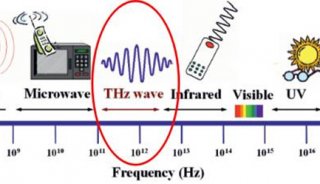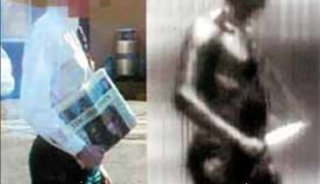使用快速太赫兹量子阱光电探测器的太赫兹光检测(三)
Discussion
In this work we demonstrate that the fast terahertz QWP detector is capable of responding 6.2 GHz modulated terahertz light. We should remind that as we already elaborated in the text the 400 × 400 μm2QWP device is working in the R-C dominant mode. Therefore, we have big space to further improve the response modulation bandwidth by optimizing the R-C circuit of the device. In Fig. 4 we plot the calculated rectified voltage for different mesa side lengths using an expanded form of Equation (1)
2
where j is the imaginary unit, τ int = 4.8 ps18 is the intrinsic carrier relaxation time, Z dev = jωL + R QWP/(1 + jωR QWP C QWP) is the total impedance of the QWP device with L being the parasitic inductance caused by the short wire bonds, R QWP the differential resistance of the QWP obtained from the V − I curve of Fig. 2a, C QWP the capacitance of the QWP. In this calculation, R QWP is set to 105 Ω level and L = 0.1 nH. As shown in Fig. 4, with decreasing the side length to 10 μm, the 3 dB roll-off frequency is expected to reach 40 GHz. If we compare the 3 dB roll-off frequency with the R-C roll-off frequency, we can find that for larger side length, although the intrinsic carrier relaxation is fast, the roll-off is limited dominantly by the R-C circuit which leads to high device capacitance and low R-C roll-off frequency. However, once the side length is reduced to 10 μm, the situation is completely different. The calculated f RC for a 10 μm side length QWP is 843 GHz which is far greater than the overall 3 dB frequency of 40 GHz, which demonstrates that for small mesas the roll-off is limited dominantly by the intrinsic carrier relaxation time.
Modelling of rectified voltage for terahertz QWPs with different dimensions. Calculated rectified voltage as a function of frequency upto 40 GHz for different mesa side lengths. For clear comparison, the rectified voltage is normalized. The horizontal ...
Due to the diffraction limit, the terahertz beam cannot be focused and confined in a 10 × 10 μm2 region. Therefore, to further improve the response speed of the current terahertz QWP, the device performance should be improved by, for instance, implementing grating coupler29, 30 or patch antenna31 techniques. On the other hand, the small QWP mesa can also work as a photomixer like a photoconductive antenna by using a metal-metal microcavity and a 50-Ω coplanar waveguide32.
It
is worth pointing out that besides the terahertz QWP presented in this
work, the Schottky barrier diodes (SBDs) and hot electron bolometers
(HEBs) have been studied for long time and they also can be used either
in direct detection or as nonlinear elements for frequency mixing (high
speed operation)33–37.
For SBDs, the main advantages are that they are able to work at room
temperature and the response frequency can reach 10 THz for direct
detection. Although SBDs don’t have the carrier relaxation time
limitation for high speed operation, the intermediate frequency (IF) of
SBD mixers is still limited by the device circuit due to the chip size,
fabrication and packaging technology. Currently the commercial SBD
mixers from Virginia Diodes can work up to few THz (greater than 2 THz
is not commercially available) with an IF bandwidth of dozens of GHz38.
Note that these high speed fragile SBD mixers are highly customized and
special attentions should be paid for operating them. Also a high local
oscillator (LO) power greater than 1 mW is required for the SBD
heterodyne detection39.
Unlike SBDs, the superconducting HEB is a thermal detector only working
at cryogenic temperature below 5 K. However, it is enough sensitive for
single photon detection37, while the NEP of SBDs lies in 10−10 W/
These two terahertz detectors, SBDs and HEBs, could be considered as strong competitors to terahertz QWPs. However, terahertz QWPs still show excellent advantages over SBDs and HEBs. Compared to SBDs, the terahertz QWP is more sensitive and the NEP is two orders of magnitude lower than that of the SBD. Therefore, in principle terahertz QWPs need less LO power for heterodyne detection than SBD mixers. In this work, we are working with the terahertz QWP at 4.2 THz which is far beyond the frequencies of the commercially available SBD mixers. Concerning the IF bandwidth, here we first demonstrate that the terahertz QWP can work as fast as 6.2 GHz. As shown in Fig. 4, the terahertz QWP is expected to work as fast as 40 GHz by optimizing the chip size. If the integrated coplanar waveguide is implemented, the speed of the terahertz QWP device can be further improved. We are hoping that after few years development the terahertz QWP can work as fast as, or even faster than the commercial room temperature SBD mixers. Compared to HEBs, terahertz QWPs show three main advantages. The first one is the operation temperature. Although terahertz QWP has to work at low temperatures, the cooling requirement is not that high as HEBs. We can operate terahertz QWPs at 20–30 K which is 20 K higher than HEBs. For the space heterodyne applications, this is a big improvement. The second one is that the HEB is easy to get saturated when it is illuminated by an external radiation, which makes it difficult for laser detection and active imaging applications. Nevertheless, the terahertz QWP has a much wider dynamic range and is suitable for various applications. The third advantage is the IF bandwidth. It is difficult to get an IF bandwidth larger than 7 GHz for HEB mixers. However, for terahertz QWPs, as we discussed before, the IF bandwidth can be significantly improved by optimizing chip size and antennas. A Single pixel HEB mixer pumped by a QCL LO has been already used for heterodyne detection of the neutral oxygen line40. Similarly, the terahertz QWP with a wavelength-matched QCL LO can be also used for terahertz heterodyne detections either on a balloon platform or in a satellite because of the above-mentioned advantages. Anyway, same as HEB mixers, it is still problematic to integrate the terahertz QWP and the QCL LO on a single chip though they are based on GaAs/AlGaAs materials and the fabrication processes for both devices are rather similar. One possibility to achieve the integration is to bond the QWP and QCL chips onto a patterned submount/carrier.
In conclusion we have demonstrated the fast detection of 6.2 GHz modulated terahertz light using a terahertz QWP equipped with a 50-Ω microwave strip line for high frequency signal extraction. The calculation of frequency-dependent rectified voltage has shown that the modulation response bandwidth is limited by the R-C circuit roll-off for larger size QWP mesa. However, for smaller mesa the response bandwidth is mainly limited by the intrinsic carrier relaxation. Besides the fast terahertz detection, the technique presented in this work can also be used for optically characterizing the frequency stability of terahertz QCLs, heterodyne detections and photomixing applications.
-
科技前沿














